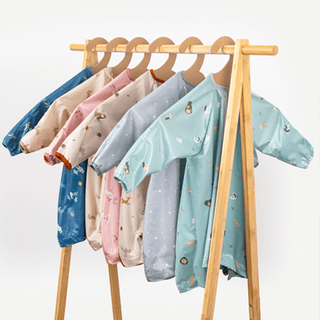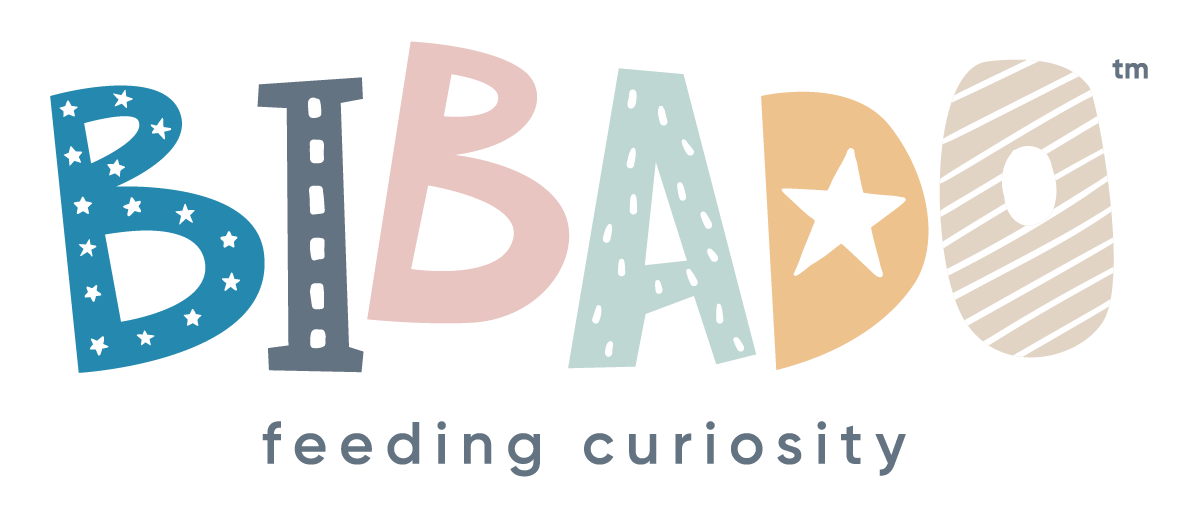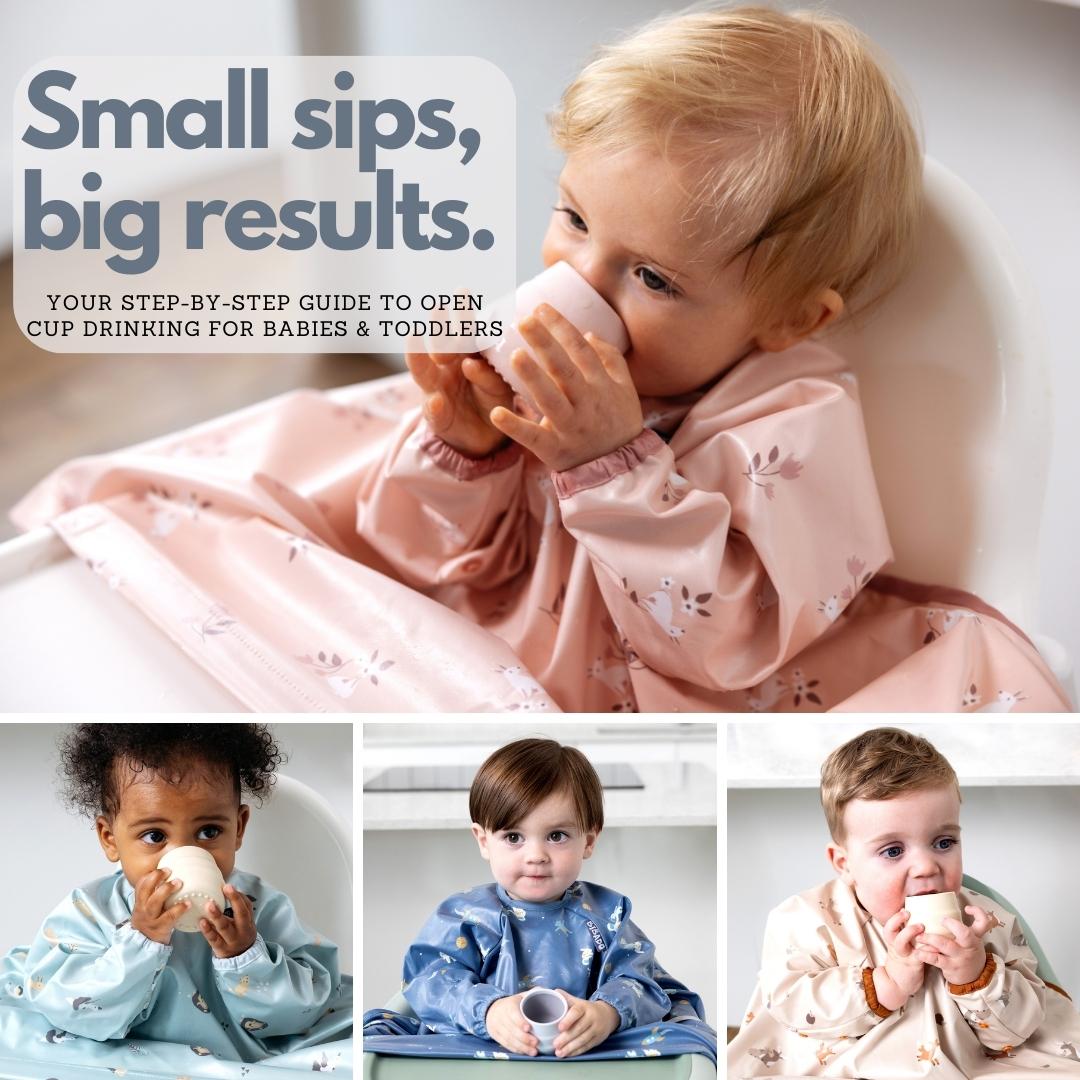Mealtime adventures are better with Bibado! Let our award-winning products make a difference to your weaning journey.
 Shop Now
Shop Now



Did you know that the ideal first cup for your baby to drink from is an open cup?
Transitioning from breast or bottle to cup drinking is another critical milestone in your baby’s development, so we’ve put together a complete guide on how and when to get started, and what to look for in an open cup. With our Small Sips, Big Results step-by-step guide to open cup drinking for babies and toddlers, you’ll find everything you need to give them the best start to their weaning adventures.
Sippy or Open cup?
The advice is varied on this one, and some experts do advocate using sippy straw cups and open cups interchangeably. The majority of advice and research does suggest moving straight to open cups, and the reason for this is simple but very compelling. The mouth actions required to drink from a straw are very similar to drinking from a bottle or breast and encourage suckling. The tongue is placed down towards the front of the mouth. At six months old, your baby can already do this, and you don’t want to keep them stuck in the same holding pattern. This can lead to delayed speech and the inability to manage and process textures, which in turn can lead to picky eating.
Helping them progress and advance their oral motor skills is only going to help them develop. Drinking from an open cup encourages elevation of the tongue and requires it to move to the top of the mouth to help create a wave-like motion that brings the liquid down for swallowing. Open cups are perfect for mastering this action!
Why you need to teach your little one open cup drinking
Here are just some of the reasons why drinking from an open cup is essential for your little one’s development:
Motor Skill Development: Drinking from an open cup requires the use of fine motor skills and hand-eye coordination. Babies and toddlers need to master holding the cup, controlling the flow of liquid, and using both arms to bring it up to and into their mouths. This process helps them refine their motor skills, leading to improved dexterity and coordination.
Oral Motor Skills: Open cup drinking encourages the development of oral motor skills. These skills are fundamental for eating, moving food around the mouth and swallowing. Babies and toddlers need to use their mouth and tongue muscles to sip from an open cup. This action helps develop flexible and strong lips and strengthens the jaw, tongue and cheek muscles and the swallow mechanism, which is crucial for speech development.
Cognitive Development: Open cup drinking can also contribute to cognitive development. Children learn cause and effect when they tilt the cup and see the liquid flow into their mouth. They also develop a sense of spatial awareness as they gauge how much liquid to sip without spilling.
Independence: Transitioning to open cups promotes independence. It allows children to have control over their drinking, fostering a sense of autonomy. This independence is important for their self-esteem and self-confidence.
Sensory Experience: Drinking from an open cup provides a sensory experience that sippy cups or bottles can't replicate. Children can feel the temperature and texture of the liquid, which can help them develop a better understanding of their environment.
Transition to Healthy Beverages: Encouraging open cup drinking can help children transition to healthier beverage choices, such as water or milk. It allows parents to gradually reduce their child's reliance on sugary or unhealthy drinks often found in sippy cups or bottles.
Social Development: Sharing a drink from an open cup with caregivers or peers can be a social experience. It provides opportunities for bonding and interaction, contributing to a child's social development.
Hydration and Health: Teaching children to drink from open cups ensures they get enough fluids for proper hydration. It also reduces the risk of dental issues associated with prolonged bottle use, such as tooth decay.
Ready to help them sip their way to success?
Now we’ve looked at the reasons why open-cup drinking is so important; it’s time to get down to the fun part. Let’s start by looking at when to start and how to choose your perfect first baby training open cup.

At what age can I start open cup drinking with my baby?
Experts suggest the optimum time to get started is when you’re already transitioning to solids - usually around six months plus. Around this time, your baby will need a little extra water at mealtimes in addition to their breast or bottle feed. This helps prevent constipation and will also help them wash down their food.
The same guidelines for readiness for starting solids apply to open cup drinking. Your little one needs to be able to sit up and support their own head, unaided. They should be safely secured into their high chair and sitting upright, not slumped.
How to choose your open cup
There are two key things to look for initially, and that’s the material and the size. These were the most important considerations in the development of the Bibado Sippit™.
A soft or semi-soft rim is optimal, for the simple reason it is kinder to little mouths and developing teeth. Remember, they’re only just getting the hang of motor control, so there is every likelihood your little one will be a little unsteady at first and may bring the cup to their face more quickly or with less accuracy and control initially. A softer material like our baby-safe, medical-grade silicone is more flexible and easier for them to work with.
The Sippit™ has been designed with little hands and mouths in mind. To you and I, the amount of water it holds may seem very minimal. What’s key for the early days and months is quite literally getting to grips with an open cup. That means being small enough to grasp and hold with two hands and small enough to lift and bring to the mouth. At this stage, refining the actions required to drink from an open cup is what’s most important. That’s why these types of cups are often called baby training cups.
Other features to consider (the Sippit™ has all of these!)
Patience - this is key for almost any baby milestone you can think of. Remove any time pressures, and always be sure you are feeling in the zone. Learning new tricks inevitably involves a few tears, the odd tantrum and a few spills and splashes here and there. The latter can be covered by using a 100% waterproof Bibado Coverall Weaning Bib - this will keep them dry and engaged for longer. Soggy babies are very rarely ready for new adventures! Trust your little one to go at their pace, and never try to move fast. If they’re showing signs of restlessness, lack of interest or heading for a wobble. Call it a day and try again at your next mealtime.
Start small - that’s why our Sippit™ has a deliberately small capacity. You wouldn’t want to feel like you were lifting a bucket to your head to drink, so don’t be tempted to fill the open cup to the brim. Let them master small sips at first and get the hang of balance, control, and handling the cup.
Gentle guiding - you can help them guide it gently to their face by cupping your hands over theirs and assisting them as they practise lifting it up to their mouth.
Tilt and touch - once they’ve reached their mouth or if you’ve helped them, gently tilt the cup so that the water touches their lips. You’re looking for them to activate the closure of their lips around the cup rim so you can pause and hold it there for a second or two.
Modelling - our Sippit™ comes in a two-pack, so you can use one to demonstrate the actions at the same time or show them using your cup. Make encouraging sounds like ahh and mmm to indicate that the liquid reached your mouth.
Encourage and nurture - avoid overreacting to spills or dropped cups. It’s all part of the learning curve. Reassure them and minimise stress by making it part of the fun. Incorporate laughter and fun in the process, and try not to show frustration.
Practice makes perfect - look for as many opportunities to practise. Even if they want to handle the cup and get used to the sensation of it without liquid at first, that’s okay, too. Make it a regular part of your mealtime set-up, and it’ll become second nature in no time.

Now you're ready to start helping them sip their way to success! Check out our baby-safe silicone Sippit open training cups here.
We’d love to see you mastering open cups with your little one. Make sure you share your progress by tagging us in your pics @bibado
Follow us for more delicious, nutritious bite-size Bibado goodness